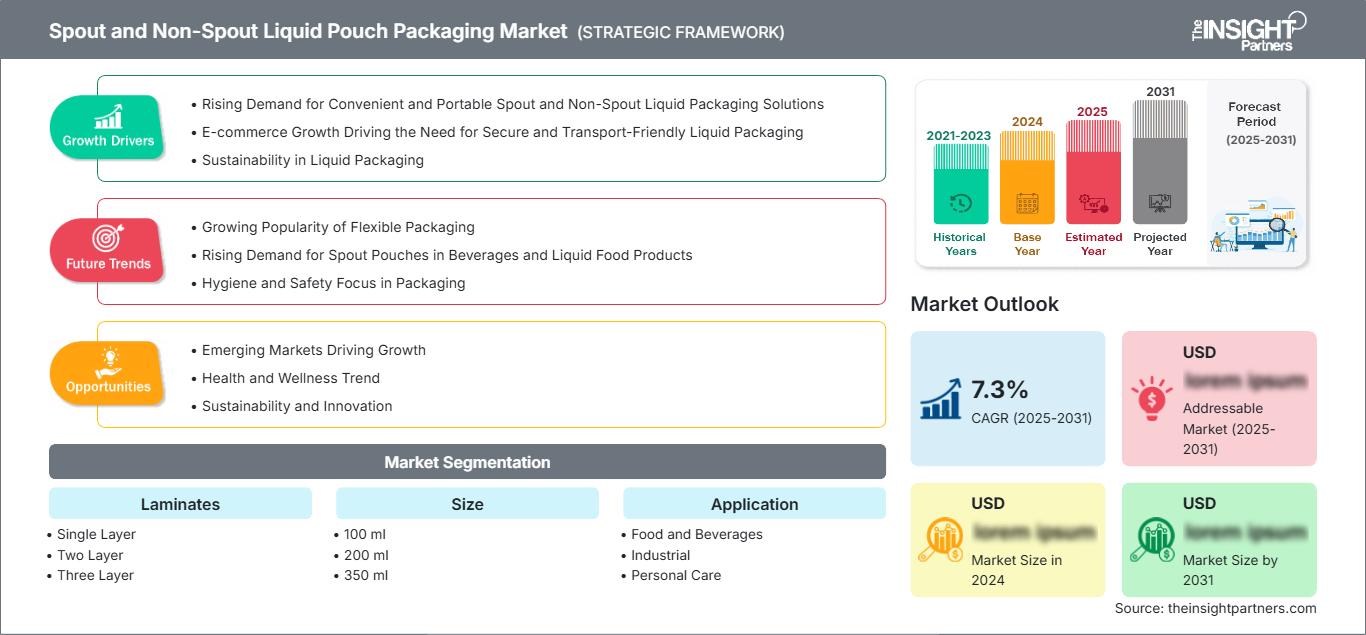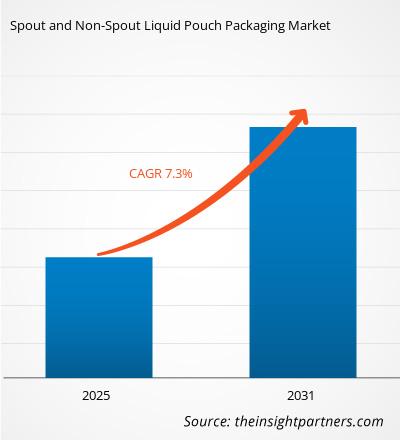预计从 2025 年到 2031 年,带嘴和非带嘴液体袋包装市场的复合年增长率将达到 7.3%,市场规模将从 2024 年的 XX 百万美元扩大到 2031 年的 XX 百万美元。
该报告按层压板(单层、双层、三层和四层及以上)细分。该报告进一步按尺寸细分(100 毫升、200 毫升、350 毫升、500 毫升、750 毫升和 1 升及以上)。该报告还根据应用(食品和饮料、工业、个人护理、家庭护理、制药等)进行了分析。报告范围涵盖五个地区:北美、欧洲、亚太地区、中东和非洲、南美和中美以及每个地区下的关键国家。全球分析进一步按区域和主要国家细分。报告以美元提供上述分析和细分的价值。
报告目的
Insight Partners 撰写的《吸嘴和非吸嘴液体袋包装市场》报告旨在描述当前形势和未来增长、主要驱动因素、挑战和机遇。这将为各业务利益相关者提供见解,例如:
- 技术提供商/制造商:了解不断变化的市场动态并掌握潜在的增长机会,使他们能够做出明智的战略决策。
- 投资者:对市场增长率、市场财务预测以及整个价值链中存在的机会进行全面的趋势分析。
- 监管机构:规范市场政策和警察活动,以最大程度地减少滥用,维护投资者的信任和信心,并维护市场的完整性和稳定性。
带吸嘴和不带吸嘴液体袋包装市场细分 层压材料
- 单层
- 双层
- 三层
- 四层及以上
尺寸
- 100 毫升
- 200 毫升
- 350 毫升
- 500 毫升
- 750 毫升
- 1 升及以上
应用
- 食品和饮料
- 工业
- 个人护理
- 家庭护理
- 制药
地理
- 北美
- 欧洲
- 亚太地区
- 南美和中美
- 中东和非洲
您将免费获得任何报告的定制,包括本报告的部分内容,或国家级分析、Excel 数据包,以及为初创企业和大学提供超值优惠和折扣
带嘴和不带嘴液体袋包装市场: 战略洞察

- 获取本报告的主要市场趋势。这个免费样本将包括数据分析,从市场趋势到估计和预测。
带吸嘴和不带吸嘴液体袋包装市场增长动力
- 对便捷便携式带吸嘴和不带吸嘴液体包装解决方案的需求不断增长:消费者对便捷包装的需求将在各个方面持续增长,尤其是在忙碌的生活方式下。带吸嘴和不带吸嘴液体包装为液体包装提供了更实用的解决方案,使其易于倾倒、储存和运输。这一趋势在饮料、酱料、果汁和清洁产品等类别中尤为明显。随着越来越多的消费者寻求便捷便携的包装形式,带吸嘴和不带吸嘴液体包装形式因其方便、易于操作且溢出最少而吸引了大量需求。
- 电子商务增长推动对安全和易于运输的液体包装的需求:在线购物趋势日益增长,尤其是在食品、饮料和消费品领域,对坚固、安全且易于运输的包装解决方案的需求很大。带吸嘴和不带吸嘴的液体包装都比电商网站更具优势。在电商领域,产品完整性和交付时的便捷性至关重要,而这类包装有助于防止运输过程中的泄漏。液体产品能够完好无损地送达目的地,因此非常适合这个快速发展的行业。
- 液体包装的可持续性:日益转向可回收和环保材料:消费者和监管机构要求在产品采购中考虑可持续性,对环保包装的需求与日俱增。带吸嘴和不带吸嘴的液体包装均可采用可回收材料制成,从而减少其对环境的有害影响。其中一个典型的例子是PET材质的吸嘴袋,它既可回收又可生物降解。可持续包装已成为该市场强劲的增长动力,尤其在食品和饮料行业尤为普遍,消费者期望获得最环保的包装解决方案。
带嘴和非带嘴液体袋包装市场未来趋势
- 软包装日益普及:经济高效、轻便且节省空间的解决方案:软包装(包括带嘴袋和非带嘴袋)因其重量轻、成本低且节省空间而日益流行。与玻璃瓶或塑料壶等硬质容器不同,带嘴袋和非带嘴袋耗材更少,从而降低了包装和运输的总成本。此外,这些包装袋可容纳各种液体产品。饮料和液体食品对包装灵活性的需求最高。
- 饮料和液体食品对带嘴袋的需求不断增长:越来越多的碳酸软饮料采用带嘴袋包装。果汁和冰沙越来越多地采用吸嘴袋包装。易饮饮料、即饮型饮料以及酱汁、肉汁和汤也越来越多地采用吸嘴袋包装,因为这些包装形式更方便、更易于使用。消费者对分量控制、即用型和环保型包装的偏好,推高了对软包装的需求。吸嘴袋通常是硬瓶和纸盒的诱人替代品:它们易于倾倒、重量轻,而且通常保质期更长。
- 包装的卫生和安全重点:对防篡改和安全包装的需求不断增加:面对持续存在的全球健康问题,人们越来越重视卫生和安全包装。带有密封瓶或罐的无吸嘴液体包装可以防止污染,这对于注重健康的消费者来说是绝对必要的,因此推动了对保证内容物完整性的包装的需求。此外,随着消费者寻求产品确实安全的保证,吸嘴袋(尤其是可重复密封或防篡改的吸嘴袋)的需求正在增长。
吸嘴和非吸嘴液体袋包装市场机遇
- 新兴市场推动增长:吸嘴和非吸嘴液体包装市场呈上升趋势。增长强劲的一些新兴经济体包括亚太地区、拉丁美洲和非洲。可支配收入的提高、城市化进程以及对饮料、酱料和乳制品等包装液体产品的持续需求,导致各地区对液体包装的需求激增。此外,由于吸嘴袋价格实惠、使用方便且易于储存,在这些地区颇具吸引力。这些地区不断增长的电子商务市场为软包装解决方案带来了新的机遇。
- 健康与保健趋势:对植物基、有机和功能性饮料包装的需求:随着消费者健康意识的增强,对植物基饮料、有机果汁和功能性饮料等健康与保健产品包装的需求也在不断增长。液体包装(包括吸嘴包装和非吸嘴包装)提供了终极解决方案,因为它能够在不使用防腐剂的情况下,确保产品保持新鲜,同时保护敏感成分。针对这一快速增长领域的包装解决方案,例如用于冰沙或蛋白饮料的可重复密封吸嘴包装袋,为制造商提供了巨大的增长机会。
- 可持续性与创新:环保材料在液体包装解决方案中的应用机遇:随着人们对环境问题的日益关注,采用更具可持续性的吸嘴包装和非吸嘴液体包装材料进行创新显然是一个良机。这些选择包括开发可回收、可生物降解或可堆肥的包装袋,或减少吸嘴包装的塑料用量。第三,减少包装废弃物的包装袋或产品可以吸引有环保意识的消费者。那些在不牺牲产品质量的情况下尽量减少碳足迹的品牌,可以抓住机会,通过提供可持续的替代品来创造市场竞争优势。
带吸嘴和不带吸嘴的液体袋包装市场
The Insight Partners 的分析师已详尽阐述了预测期内影响带嘴和非带嘴液体袋包装市场的区域趋势和因素。本节还探讨了北美、欧洲、亚太地区、中东和非洲以及南美和中美洲的带嘴和非带嘴液体袋包装市场细分和地域分布。
带嘴和不带嘴液体袋包装市场报告范围
| 报告属性 | 细节 |
|---|---|
| 市场规模 2024 | US$ XX million |
| 市场规模 2031 | US$ XX Million |
| 全球复合年增长率 (2025 - 2031) | 7.3% |
| 历史数据 | 2021-2023 |
| 预测期 | 2025-2031 |
| 涵盖的领域 |
By 层压板
|
| 覆盖地区和国家 | 北美
|
| 市场领导者和主要公司简介 |
|
吸嘴式和非吸嘴式液体袋包装市场参与者密度:了解其对业务动态的影响
吸嘴式和非吸嘴式液体袋包装市场正在快速增长,这得益于终端用户需求的不断增长,而这些需求的驱动因素包括消费者偏好的演变、技术进步以及对产品优势的认知度的提升。随着需求的增长,企业正在扩展产品线,不断创新以满足消费者需求,并抓住新兴趋势,从而进一步推动市场增长。

- 获取 带嘴和不带嘴液体袋包装市场 主要参与者概述
主要卖点
- 全面覆盖:本报告全面涵盖了对带嘴和非带嘴液体袋包装市场的产品、服务、类型和最终用户的分析,提供了整体格局。
- 专家分析:本报告基于对行业专家和分析师的深入了解而编写。
- 最新信息:由于涵盖了最新信息和数据趋势,本报告确保了业务相关性。
- 定制选项:本报告可以根据特定客户要求进行定制,并恰如其分地适应业务战略。
因此,关于带嘴和非带嘴液体袋包装市场的研究报告可以帮助引领解读和理解行业情景和增长前景的线索。尽管可能存在一些合理的担忧,但本报告的总体优势往往大于劣势。
- 历史分析(2 年)、基准年、预测(7 年)及复合年增长率
- PEST和SWOT分析
- 市场规模、价值/数量 - 全球、区域、国家
- 行业和竞争格局
- Excel 数据集
近期报告
客户评价
购买理由
- 明智的决策
- 了解市场动态
- 竞争分析
- 客户洞察
- 市场预测
- 风险规避
- 战略规划
- 投资论证
- 识别新兴市场
- 优化营销策略
- 提升运营效率
- 顺应监管趋势




















 获取免费样品 - 带嘴和不带嘴液体袋包装市场
获取免费样品 - 带嘴和不带嘴液体袋包装市场